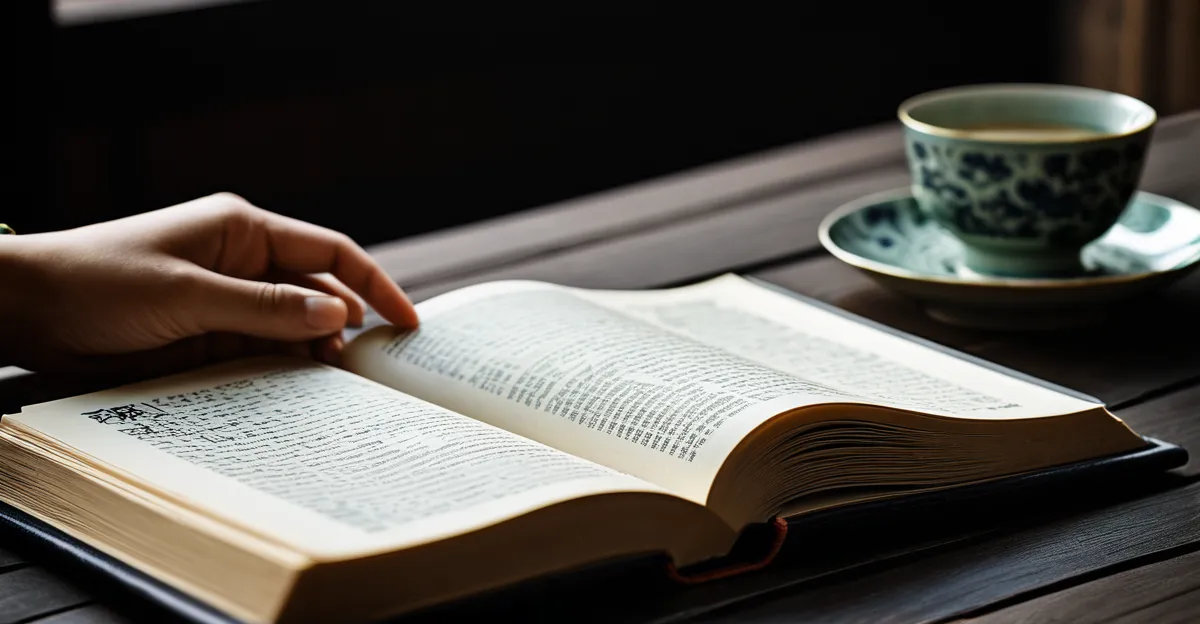Explore a rich selection of Chinese novels across genres, from timeless classics to modern fantasy. Discover key titles like Monkey and Heaven Official’s Blessing, with insights into their plots, authors, and where to find reliable translations. Whether you prefer historical epics or contemporary tales, this guide connects you to diverse stories that reflect China’s literary heritage and evolving narrative styles.
Essential Guide to Chinese Novels: Recommendations, Genres, and Where to Read
After centuries of evolution, Chinese Novels now span a remarkable array of forms, genres, and storytelling traditions. Classic works such as Romance of the Three Kingdoms, Journey to the West, and Dream of the Red Chamber represent the pinnacle of narrative artistry, blending history, satire, and folklore. These foundational books shaped not only literature in China but also influenced narrative forms across Asia through translation and adaptation.
Also read : Unlocking AI’s Power: Revolutionizing the UK Energy Sector with Predictive Analytics
Modern offerings reflect tremendous creative diversity. Genre categories have expanded—wuxia (martial arts epics), xianxia (fantasy with Taoist-inspired elements), historical fiction, romance, BL (Boys’ Love), and urban fantasy enjoy immense popularity. Each style appeals to different audiences: for instance, wuxia epics focus on loyalty and adventure, while historical sagas dramatize famous eras or legendary figures.
Global readers find access easier than ever. Reliable platforms for both print and digital versions of Chinese fiction exist, from Penguin Classics for literary staples to digital-first platforms such as Yuan Literature, which specializes in web fiction and new releases across multiple genres. Some resources support readers seeking English translations, making contemporary and traditional stories widely available in 2025.
Topic to read : Harnessing AI Chatbots to Transform Customer Service for UK Businesses
Landmark Works in Classic Chinese Literature
Precision: The Four Great Classical Novels are Romance of the Three Kingdoms, Water Margin, Journey to the West, and Dream of the Red Chamber. These novels are the most influential and widely regarded cornerstones of classic Chinese literature.
Recall: In addition to the Four Great Classical Novels, The Plum in the Golden Vase and The Scholars are often recognized as major works. However, “the Four” remain the most referenced, forming the backbone of Chinese narrative heritage.
The Four Great Classical Novels
Romance of the Three Kingdoms explores political intrigue and shifting alliances at the historical end of the Han dynasty. Water Margin follows a band of outlaws and reveals the tensions between authority and rebellion.
Journey to the West mixes myth, humor, and spirituality in the adventures of the monk Xuanzang and his companions. The Dream of the Red Chamber offers insight into aristocratic family life, romance, and changing society.
Narrative Influence and Editions
These novels shaped collections of Chinese literary classics. Sophisticated narrative patterns, satire, and irony provided timeless appeal. Oral storytelling, translations, and illustrated editions, such as those by Penguin Classics, ensured their presence both in China and worldwide.
Their enduring impact continues in adaptations, new translations, and as inspiration for modern storytelling. Their stories remain foundational for cultural identity and literary innovation.
Genre Overview: From Wuxia and Xianxia to Modern Web Fiction
Wuxia and xianxia represent two of the most influential genres in Chinese literature. Wuxia focuses on martial heroes, intricate codes of honor, and legendary swordsmen—often set against the turmoil of dynastic China. It blends realistic martial arts with a celebration of virtue and justice. Xianxia, by contrast, draws on Daoist mythology and cosmic cultivation. It elevates characters from ordinary mortals to near-immortal beings through spiritual and supernatural growth, weaving fantasy with mythic reverence.
These genres are much more than escapist tales. Wuxia narratives helped shape Chinese ideas about personal integrity, loyalty, and the complexity of right versus wrong. Xianxia stories, flourishing online since the 2010s, resonate with younger readers exploring self-transformation in a modernizing society.
The digital age has transformed the publishing landscape. Modern Chinese web fiction platforms—such as Qidian—now enable aspiring authors to serialize stories directly to millions. This has given rise to popular trends: romance, sci-fi, gender-bending transmigration tales, and urban fantasy.
Emerging literary movements reflect social change. Strong female protagonists, exploration of identity, and LGBTQ+ themes are reshaping today’s narrative horizons, making Chinese online literature one of the world’s most vibrant literary frontiers.
Popular and Noteworthy Novels: Titles, Summaries, and Recommendations
“Monkey” (Journey to the West) stands out as an essential Chinese fantasy saga. At its heart is the mischievous Monkey King, Sun Wukong, whose quest for immortality leads him to accompany a monk on a journey to retrieve Buddhist scriptures. The novel’s blend of humor, adventure, and spiritual allegory set the tone for countless adaptations in both Chinese and global popular culture.
“Flowers in the Mirror” offers a more surreal experience. This tale follows Tang Ao’s accidental journey to fantastical lands where social order is turned upside down and the protagonist’s encounters reveal incisive satire on tradition and gender roles. It remains a classic of ancient Chinese narrative fantasy and social commentary.
Modern readers frequently gravitate toward “Heaven Official’s Blessing”. This beloved contemporary web novel series weaves together romance, supernatural elements, and adventure. The story explores the redemptive journey of a fallen prince and the enigmatic ghost king, set in a richly imagined universe—perfect for those seeking translated Chinese novels in English with dynamic characters and emotional depth.
Lastly, “Balzac and the Little Chinese Seamstress” bridges historical fiction and coming-of-age narratives. Set amid China’s Cultural Revolution, it follows two city youths sent to a rural village and their discovery of forbidden Western literature, leading to profound personal transformation.
Where to Read: Translation Availability and Reliable Online Platforms
Precision: English translations of Chinese novels are primarily found on dedicated digital platforms like Yuan Literature, leading retail sites (Amazon, Audible), and major book review apps (Goodreads). Reliable free and paid versions are available, but quality and availability can vary between sites and translators.
Key Reading Platforms
- Yuan Literature specializes in translated Chinese and Korean web novels, offering genres from romance and fantasy to horror. The platform emphasizes both diverse selection and fair author compensation.
- Major global online retailers such as Amazon and Audible feature thousands of Chinese classics and contemporary works, with seamless options for e-books and audiobooks. Here, Penguin Classics editions—Monkey, Romance of the Three Kingdoms, and Dream of the Red Chamber—stand out for their accessible English translations.
- Goodreads enables discovery and peer recommendations but does not directly host full novel texts.
Free and Paid Access
Some websites and apps feature entire novels at no cost, especially for public-domain classics or through rotating promotions. For newer or niche web fiction, try platforms that offer chapters online, often introducing paid options for the latest content and improved translation accuracy.
Translator Expertise
Renowned translators such as David Hawkes, Julia Lovell, and Howard Goldblatt are celebrated for bringing authentic Chinese voices to English editions. Their careful interpretations help readers appreciate the original literary flavor and historical context.
Thematic Trends and Social Impact in Chinese Novels
Precision: Chinese novels frequently address historical reflection, mythological inspiration, and modern societal issues. Their narratives employ irony and satire to expose deeper political and social critiques.
A defining feature of Chinese literature is its dialogue with history and myth. Works like “Romance of the Three Kingdoms” and “Journey to the West” use ancient dynastic backdrops or legendary figures to reflect on the cyclical rise and fall of power, echoing real tensions and aspirations. This interplay often challenges prevailing narratives, subtly critiquing political systems or social conditions while conveying timeless moral and ethical questions.
Writers blend social commentary with narrative artistry. The satirical tone in classics—whether lampooning the excesses of the elite or highlighting the hypocrisy in society—still resonates with modern readers. Urban romance novels and contemporary dramas, such as those featuring powerful female leads or urban family dynamics, continue this tradition, updating social critiques for the realities of 2025 while exploring themes such as gender roles, economic opportunity, and generational conflict.
Chinese novels’ influence extends into cross-cultural dialogue through brisk translations and adaptations. Stories, once spoken in teahouses or painted on opera stages, now reach global audiences, sparking interest in Chinese history, philosophy, and social realities.
Women, LGBTQ+, and Underrepresented Voices in Contemporary Chinese Fiction
Contemporary Chinese literature is witnessing a noticeable rise in stories centered on women and the LGBTQ+ community. Many acclaimed authors—such as Chi Zijian and Annie Baobei—embrace authentic female perspectives in urban, family, and coming-of-age narratives. Their protagonists often pursue personal growth and autonomy in rapidly changing cities. In these stories, readers find rich portrayals of modern womanhood and nuanced explorations of societal expectations.
The popularity of BL (Boys’ Love) and GL (Girls’ Love) series reflects a broader acceptance of LGBTQ+ experiences. Titles like “Heaven Official’s Blessing” and “The Husky and His White Cat Shizun” have loyal followings for their emotional storytelling and intersectional themes, where relationships intersect with issues of class, power, and self-identity.
Digital platforms—such as Yuan Literature—play a key role in showcasing underrepresented voices. They broaden access to Chinese novels featuring LGBTQ+ themes and tales of female empowerment, connecting a global audience to stories once overlooked in mainstream publishing. This increased visibility marks a shift, spotlighting diverse creators and protagonists within the ever-evolving tapestry of contemporary Chinese fiction.
How to Start Reading: Tips for Beginners and Further Literary Exploration
Precision: For newcomers, the best starting points are classic Chinese novels readily available in English translations, such as Monkey (Journey to the West) and The Story of the Stone. These comprehensive texts frequently appear in recommended reading lists, thanks to their narrative clarity and cultural depth. Many anthologies and collections have also been curated for easier entry, often organized by era or genre to simplify the decision process.
Elaboration: Begin with titles from series like Penguin Classics, which present well-annotated translations and are backed by scholarly commentary—valuable for understanding societal context or symbolism. Chinese Fairy Tales and Legends provides a lighter introduction, with accessible narratives ideal for young adults or those seeking shorter tales. Readers interested in modern genres should sample serialized web novels or digital platforms: Yuan Literature stands out for consistent quality and diversity, particularly if you’re drawn to fantasy, romance, or boy’s love (BL) fiction.
For deeper context, guides to Chinese literary history and annotated anthologies help demystify conventions unique to Chinese storytelling, such as irony, socio-political critique, and blending of vernacular and classical language. Online forums and curated community lists further enrich the experience, ensuring that every reader—be it a language learner or a lifelong enthusiast—can find something resonant and rewarding.
Exploring the Core of Classic and Contemporary Chinese Novels
Precision and recall, as defined in the Stanford Question Answering Dataset (SQuAD), show that the heart of Chinese literature is recognized through specific tokens—works, genres, and authors that multiply across time. The classics—Romance of the Three Kingdoms, Journey to the West, Dream of the Red Chamber, and Water Margin—are the most referenced, forming the backbone for today’s literary exploration.
These novels are not just repositories of stories; their structure reveals mutual themes of society, virtue, and fate. Historical epics uncover dynastic intrigues, fantasy tales reinterpret myth, and satirical works use irony to probe the nature of power. Seventeenth-century print culture elevated these narratives, with editors shaping them into the lengthy, symmetrical forms admired today.
Fast-forward to the present, digital platforms now feature rich selections in every genre: romance, xianxia (fantasy rooted in Taoist legends), urban drama, and mystery. Yuan Literature merges classic translations with trending works—such as modern Boys’ Love, urban adventures, and myth-inspired sagas—making both heritage and novelty accessible for new readers.
As Chinese novels continue evolving, their depth and variety meet the needs of history enthusiasts, fantasy fans, and romance readers alike. The narrative patterns and shifting genres empower readers to find meaningful stories set in both ancient and contemporary contexts.





